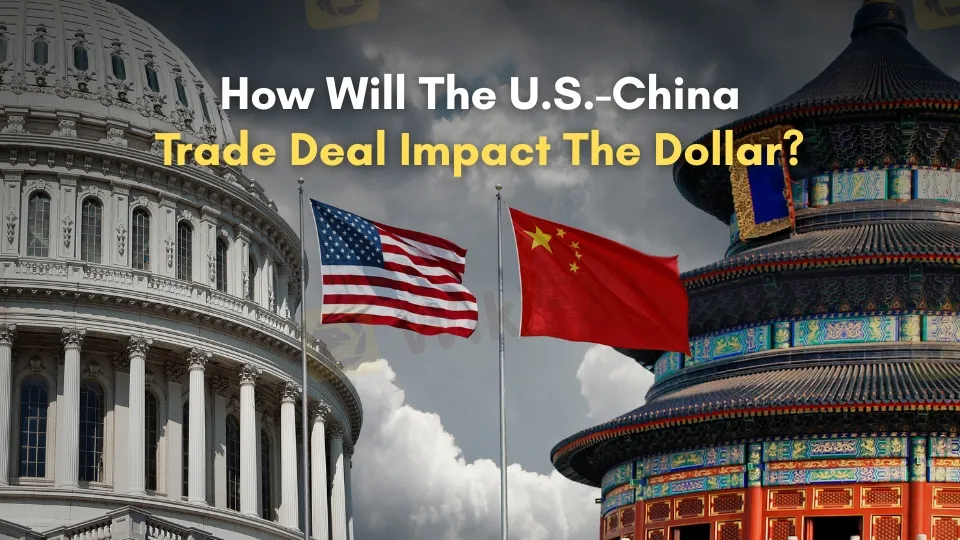简体中文
繁體中文
English
Pусский
日本語
ภาษาไทย
Tiếng Việt
Bahasa Indonesia
Español
हिन्दी
Filippiiniläinen
Français
Deutsch
Português
Türkçe
한국어
العربية
How Will the U.S.-China Trade Deal Affect the Dollar and Global Markets?
Abstract:The U.S. dollar surged after the U.S. and China agreed to temporarily cut tariffs, easing concerns over a global recession and boosting market sentiment.

On Monday, a breakthrough in U.S.-China trade talks sent the U.S. dollar climbing and ignited a surge in global stock markets. The two economic powerhouses struck a temporary deal to scale back tariffs, calming fears that their ongoing trade spat could drag the world into a recession. This unexpected agreement has injected a dose of optimism into financial markets, with investors eagerly watching what comes next.
Under the deal, the U.S. will slash extra tariffs on Chinese goods from 145% to 30%, while China will lower its duties on U.S. imports from 125% to 10%. The truce, set to last 90 days, gives both nations a chance to work toward a longer-term resolution. “This pause is a relief, but it‘s just a breather,” said Sarah Mitchell, a trade analyst at Horizon Economic Group in Boston. “We’re still far from solving the deeper issues driving this conflict.”
The agreement caught many by surprise, as earlier talks had hinted at little progress. Yet, the news was a boon for markets. The U.S. Dollar Index, which measures the dollar against major currencies like the euro and yen, jumped 1.5% to 101.91. The euro took a hit, dropping 1.54% to $1.1074—its biggest single-day slide since early November. The dollar also gained 2.19% against the Japanese yen, reaching 148.50, its highest since April, and rose 1.86% against the Swiss franc to 0.847. The British pound wasnt spared, falling 1.07% to $1.3162, marking its steepest daily drop since April.

U.S. stocks rode the wave of optimism, with the S&P 500 soaring over 3%. Safe-haven currencies, typically favored during uncertain times, lost ground as investors embraced riskier assets. “The market‘s cheering this deal, but it’s a short-term fix,” Mitchell noted. “The next 90 days will be crucial to see if both sides can build on this momentum.”
Despite the dollar‘s recent gains, it’s still down 2.2% since April, when President Trump‘s sweeping tariff announcements rattled markets. The uneven rollout of those policies sparked volatility, shaking confidence in U.S. assets. Now, attention is turning to key economic data: Tuesday’s Consumer Price Index (CPI) and Thursdays retail sales figures. These reports will shed light on how the trade dispute has affected the economy and shape expectations for Federal Reserve interest rate moves.
Investors are rethinking their bets on rate cuts, with the trade deal easing economic concerns. Many now expect the Feds first 25-basis-point cut in September, a shift from earlier predictions of a July move. “This deal gives the Fed room to hold steady on rates, which supports the dollar for now,” said analysts at Cornerstone Wealth Advisors. The Chinese yuan also saw a modest gain, rising 0.52% to 7.201 against the dollar, signaling cautious optimism in China.
Beyond trade, the weekend brought relief on the geopolitical front. India and Pakistan agreed to a ceasefire after days of border clashes, soothing jittery markets. Meanwhile, Ukrainian President Volodymyr Zelenskyy signaled openness to meeting Russian President Vladimir Putin in Turkey for talks—the first potential dialogue since Russias 2022 invasion of Ukraine. These developments have bolstered global risk sentiment, adding to the positive market mood.
As the dust settles, investors are hopeful but cautious. The U.S.-China trade truce is a step forward, but whether it leads to lasting progress or just delays tougher challenges remains to be seen.

Disclaimer:
The views in this article only represent the author's personal views, and do not constitute investment advice on this platform. This platform does not guarantee the accuracy, completeness and timeliness of the information in the article, and will not be liable for any loss caused by the use of or reliance on the information in the article.
Read more

Top Reasons Why FXCM is Your Go-to-Broker for Forex Trading
A revered broker name is what you want to associate with being a forex trader. Fortunately, you have plenty of such names on WikiFx where the best forex brokers and regulators are listed to ensure your transaction is genuine. One such name is FXCM, a regulated forex broker in the United Kingdom (UK). Let’s check out more details about FXCM through this article.

Scammers Use AI to Fake Lim Guan Eng’s Support for Investment Scheme
A fake video showing former Penang Chief Minister Lim Guan Eng promoting an investment scheme has started spreading online. Lim has come forward to say the video is not real and was made using artificial intelligence (AI).

IronFX: A Closer Look at Its Licences
In an industry where safety and transparency are essential, the regulatory status of online brokers has never been more important. For traders seeking to protect their capital, ensuring that a platform operates under recognised and stringent oversight can make all the difference. Keep reading to learn more about IronFX and its licenses.

Spot vs Forward Contracts - Which Should You Choose?
Mulling foreign exchange contract options - Spot vs Forward - to begin or consolidate your trading journey? Read this comprehensive guide explaining the differences between spot and forward contracts. You can select better using it.
WikiFX Broker
Latest News
IronFX Broker Review 2025: A Comprehensive Analysis of Trustworthiness and Performance
OctaFX Flagged by Malaysian Authorities
OctaFX and XM Trading Platforms to Be Blocked in Singapore
ATFX Opens New Office in Cape Town's Portside Tower to Expand in Africa
Tighter Scrutiny: Finfluencers Face Global Crackdown Amid Rising Risks
IronFX: A Closer Look at Its Licences
2025 Broker Real - World Reviews: Share Your Insights & Grab Thousands in Rewards!
Eid ul Adha Celebration Continues – Grab the STARTRADER Offer Now!
Nonfarm Data Lifts Market Sentiment, U.S. Stocks Rebound Strongly
Interactive Brokers Enhances PortfolioAnalyst with New Features
Currency Calculator


